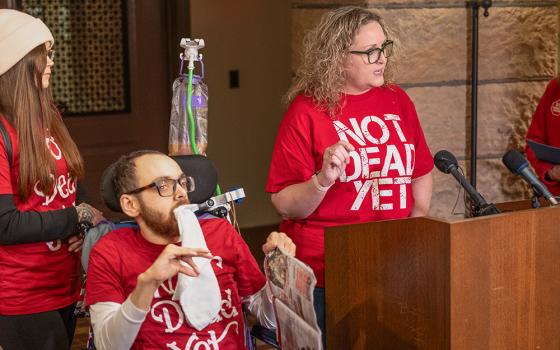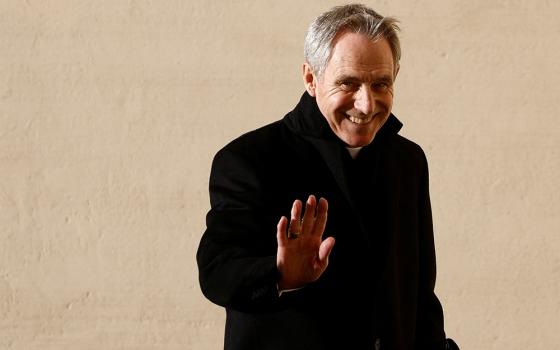Editor's note: This is the second of a two-part blog series. Click here for part one.
The other day I wrote about the history of the ecumenical monastic community of Taizé, which celebrated this month what would have been the hundredth birthday of its founder, Br. Roger Schütz; the 10th anniversary of his death; and the 75th anniversary of its establishment in Burgundy, France.
I would like to say a little more about the community as it exists today.
In honor of its triple anniversary, after special conferences earlier in the summer that convened theology students and vowed religious, the community enjoyed a week of special meetings with young people from around the world — a survivor of armed conflict in the Ukraine, witnesses of religious persecution in Havana, and others — who spoke about the reality of life in church and society in their particular global contexts.
But how did a little monastery in the middle of France become the venue for an international exchange of diverse socio-cultural realities?
A little-known side of Brother Roger was his extraordinary interest in the suffering of the poor, particularly children and young people. A friend of Mother Teresa, he would visit her in Calcutta and even agreed to her request to adopt, together with his sister, a sickly orphaned Indian girl who was otherwise at risk of dying on the streets.
He also traveled widely throughout Africa, Latin America and Asia, convinced that — as he put it in an unfinished letter he was composing to the world's youth at the time of his death in 2005 — "whoever lives a life rooted in God chooses to love…[and] all who choose to love and to say it with their life are led to ask themselves one of the most compelling questions of all: how can we ease the pain and the torment of others, whether they are close at hand or far away?"
For decades, then, beginning under Brother Roger's inspiration, the Taizé brothers have undertaken a "pilgrimage of trust on earth," meeting every New Year's in a different European city (in 2015-16, it will be Valencia, Spain) to animate tens of thousands of pilgrims with a program of prayer and exhortation toward what the community calls a "new solidarity" with those around the world who suffer the adverse effects of globalization. This has been the theme of other meetings throughout the years, too, particularly a number that have taken place in Africa. For instance, the community is currently preparing for an event in Cotonou, Benin, next September.
"Across the earth," the community's current prior, Br. Alois Löser of Germany, has written, "new calamities, new forms of solitude, new and burning issues — displaced populations, ecological catastrophes, inequalities, massive unemployment, different forms of violence call for new expressions of solidarity."
One instance of this new solidarity was a magnificent event on the Pine Ridge reservation in the Badlands of South Dakota in 2013. A number of young Lakota Sioux — with the unanimous consent of the tribal council of elders — invited the Taizé brothers to hold a prayer meeting on the reservation. The several hundred pilgrims who attended made it the largest gathering of non-native people on the reservation since the Wounded Knee massacre in 1890. It was a moment of profound reconciliation — and a time, too, for young Americans to share the cultural life and see the social needs of the largely invisible, marginalized native population.
The Taizé brothers are currently planning their next visit to the United States, and my conversations with them suggest that they are working with the American church to explore the contribution they can make to peace and justice efforts in other areas of society where social and racial reconciliation is desperately needed.
In mid-August, to the applause of thousands of people gathered in Taizé for the celebration of its anniversaries, Brother Alois also announced another gesture of solidarity: the creation of a new community of brothers in Cuba. "Cubans, especially the young, need to feel close to young people in other countries," he said, suggesting that the brothers who travel there to share their life with them can be a ferment of hope in the future of the Cuban church. For young Cubans, he added, "becoming salt of the earth means taking an option of hope."
This would not be the first time the Taizé community has lent its presence to a country where church life is threatened; in the late 80s, for instance, it smuggled one million copies of the New Testament into major cities in Russia, and it replicated this feat recently in China.
Such initiatives are signs that the community under Brother Alois is following faithfully in the footsteps of its beloved founder. On the last afternoon of his life, Brother Roger, his wrist broken and unable to write, dictated the beginning of a sentence to one of his brothers who was helping him in the creation of a new book. "To the extent that our community creates possibilities in the human family to widen. …," Brother Roger mused, leaving his thought unfinished.
"Widen" — in French, élargir — this was his last written word. That evening, while at prayer in the church, a woman stabbed him to death with a knife. A few of the brothers who were seated around him rushed him into another room, where he died. Many of the worshipers — transported by prayer in a church full of people — hadn't seen what happened. They kept on praying. One of the brothers speculated to me that as Brother Roger lost consciousness while being carried out of the church, the last thing he would have heard was the music continuing all around him.
Nothing changed in the way the community welcomes pilgrims after Brother Roger's death. They continue to take in everyone who comes in search of peace, connection, reconciliation: no background checks, no metal detectors. As one brother puts it in a new documentary video soon to be released on the life of Brother Roger, the abbot of Citeaux expressed in a letter of condolences to the community that the way Brother Roger died is somehow fitting: However shocking and violent his death may have been, Roger's life had always been lived in a spirit of vulnerability.
"What I need to verify," Paul Ricoeur, the famed philosopher and friend of the community, once said, "is that however radical evil may be, it is not as deep as goodness. And if religion, if religions have a meaning, it is to liberate that core of goodness in human beings, to go looking for it where it has been completely buried. Now here in Taizé I see goodness breaking through, in the community life of the brothers, in their calm and discreet hospitality, and in the prayer. I see thousands of young people who do not express a conceptual articulation of good and evil, of God, of grace, of Jesus Christ, but who have a fundamental tropism towards goodness."
I will leave the last words to Brother Roger, on whose very face one can read this tropism toward goodness. This gentle face was a living icon of the Gospel, of a spirituality that can perhaps be captured in a prayer he wrote many years ago: "Those who surrender themselves to you with a trusting heart, O God, are happy. You sustain us in joy, in simplicity, in mercy."
Here he is in a video, then, talking about his vision for his community.
To find out more about visiting Taizé, please see their website: http://www.taize.fr/en_rubrique9.html.
[Nicholas Collura received his Master of Divinity from the Boston College School of Theology and Ministry in 2014.]
Editor's note: This post has been updated, Aug. 27, 2015 regarding the person who caused Schütz's death.




